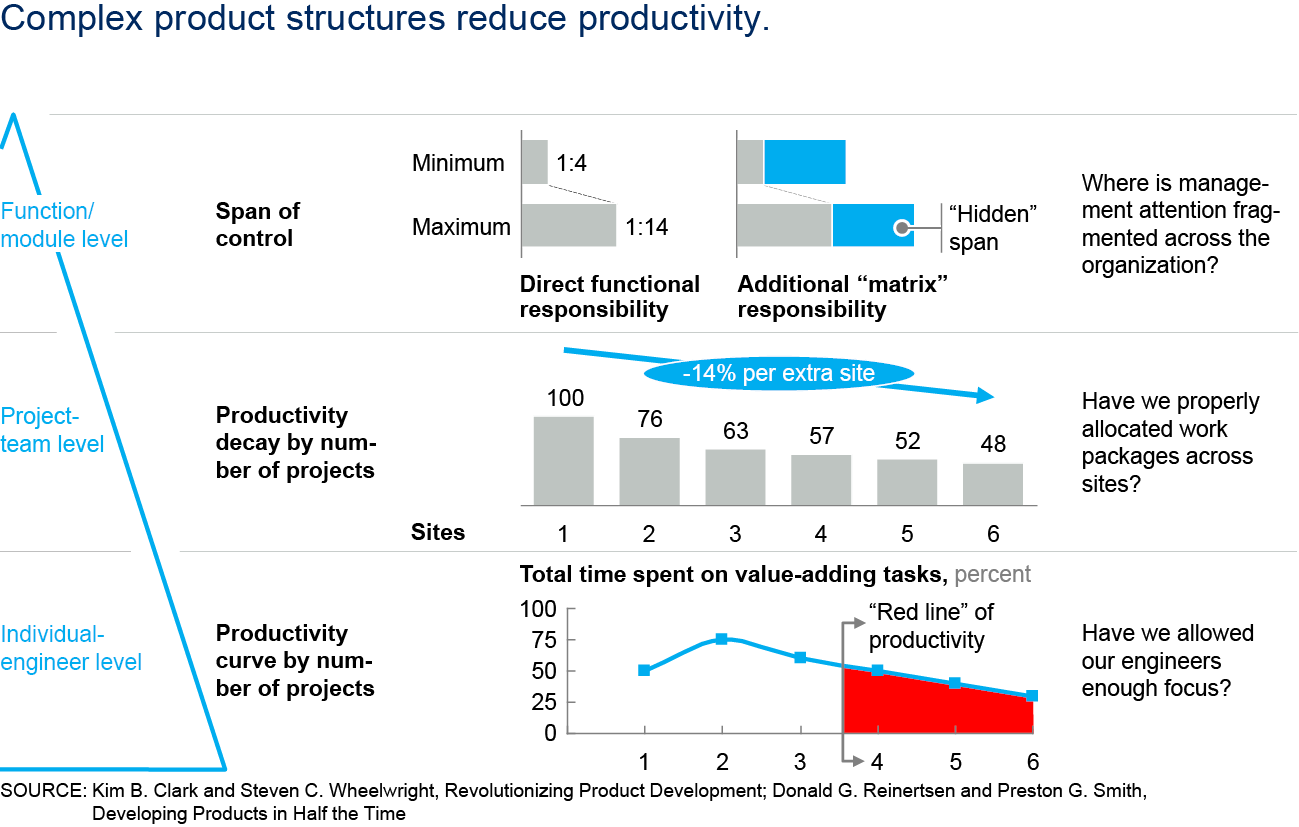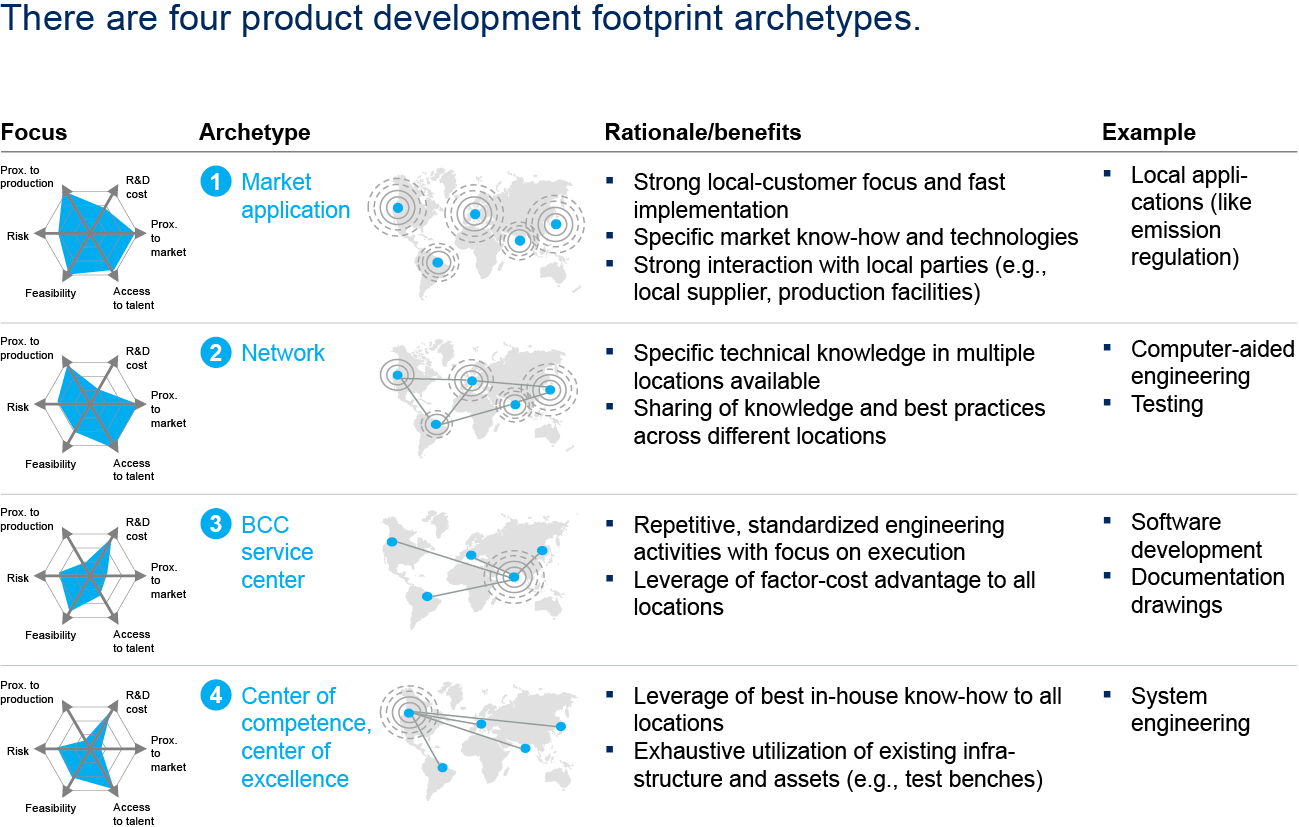Rapid growth can make a mess of an R&D network. Stitching it back together can lead to big payoffs.
R&D networks can get pretty tangled, especially after acquisitions and rapid growth. Knitting them together pays off for companies willing to make the effort.
For many large corporations, decades of organic growth, acquisitions, and divestments have created a complex, opaque product development footprint. Facilities are dispersed across multiple countries or even continents, so teams often work in different time zones and speak different languages. Some companies have hundreds of these locations, ranging in size from one or two local teams to large central hubs with hundreds of researchers. When a footprint reaches this level of complexity, the entire product development organization may need to get involved to help projects reach the desired outcomes.
Of course, maintaining a cohesive organization is challenging in the face of such complexity. Focused, coordinated product development and research are difficult—if not impossible—when capabilities and knowledge are distributed around the globe. The productivity of a development team drops by 14 percent, for example, with each site added to its network, as research—both by academia as well as by our teams—has shown (Exhibit 1).

Furthermore, the portfolios that product development organizations support—both the number of products and the technology and know-how required to develop them further—are often complex, too. Units acquired through M&A typically maintain an independent mind-set and plan their product portfolios without considering the knowledge in other departments. A number of road maps may therefore compete within the same organization, and teams that do not even know what other teams are working on may be developing similar products.
The wide dispersal of knowledge and skills compounds the challenges organizations encounter as they seek to acquire the competencies needed to keep up with new industry trends and market developments. Each location must adapt to the changing landscape by undertaking its own efforts to attract top talent with relevant new skill sets. These moves often make product development structures across the organization more complex and opaque.
Recognizing the pitfalls of these structures, many organizations have sought to optimize their footprints. Unfortunately, a lack of transparency has impeded such initiatives. Moreover, optimization programs focus primarily on the business-unit level, where opportunities to capture improvements are much more limited than they are at the division or company level.
How can companies address the challenges of optimizing the product development footprint? In this chapter, we describe the process and the enablers.
A four-step process for optimization
It is critical to take the right steps to transition from existing structures to a state-of-the-art product development footprint—the best plan for the future will not matter if the process for implementing it is not in place. Our experience suggests that the following four steps are essential.
Establish a clear fact base
The first and most important step is to create transparency by obtaining a comprehensive baseline, which provides the basis for the transformation. The organization should not only consider its ideal future in the context of its baseline but also adjust its vision of the future to account for the constraints that legacy structures impose.
A comprehensive baseline includes the number of development locations by city, country, and region; the distribution of each type of development work (for example, maintenance versus new products); and existing skills and competencies by location. Most organizations will find that this type of information is not readily available and must be collected, bottom up, from each product development department. Standardized templates, as well as clear, open, and up-front communication, are required to ensure an effective process and to promote buy-in throughout the organization.
Match existing competencies with required skills
To achieve its vision of the future, the organization needs to understand the skills and competencies it must build or acquire. To determine which gaps to close, existing know-how at the business-unit level must be mapped against what is required for planned products or services and their underlying technologies. This matching exercise is critical. The second chapter of this book on skill ecosystems details this approach.
The organization should understand the current product and technology road map for all business units—as described in the first chapter of this book—and determine their required future knowledge profiles, taking a companywide perspective when it assesses and reviews their product development strategies. By consolidating these road maps, the organization can identify their overlaps and gaps, as well as generate plans—for instance, streamlining parallel or overlapping development activities—to address these issues globally.
This review establishes the basis for distinguishing between the core knowledge areas that must be developed in house and noncore skills and activities that can easily be outsourced. The goal is to create centers of competence for the knowledge areas in which the company wants to generate intellectual property.
Develop a vision of the future and align design principles
Once the organization creates transparency and defines the requirements for its future skills and competencies, it can turn to creating a new product development blue-print. To gain a clear understanding of where the next generation of products will be developed, it should also consider the corporate strategy. Companies ought to balance five dimensions when they redesign their product development:
- Access to market information, to gain customer insights and stay close to market developments,
- Access to talent, to ensure that the company can attract and retain highly skilled people,
- Access to technology, especially technology developed by start-ups disrupting traditional industries,
- Reduced complexity and simpler interfaces, to ensure that work packages can be distributed and that the process is manageable, and
- The cost of R&D—hourly rates, as well as expenses for quality and coaching.
Organizations are likely to find that their historical landscapes and structures do not match the ideal blueprint. Consequently, it is important to understand which parts of the legacy can be changed easily and which should be protected. In some cases, companies will also face regulatory constraints in optimizing their footprint. The organization ought to evaluate its legacy structures carefully to determine the possible compromises between full-scale change and preserving the status quo.
The prioritized design parameters provide a basis for the optimal design archetype of the product development network. As Exhibit 2 shows, we distinguish among four typical setups:

- Market application. Product development is located close to customers to enable a strong customer-centric focus.
- Network. R&D centers are close to universities and technology hubs to facilitate access to talent and innovations; interfaces to share knowledge are critical to success.
- Best-cost country service center. Products are developed at locations that make it possible to leverage factor-cost advantages and to increase the utilization of infrastructure assets.
- Center of competence and center of excellence. These hubs help all locations to access the best in-house knowledge.
For example, if an organization is optimizing to ensure that product development takes place close to production, a market-application or network archetype can be a good starting point for the blueprint. Refinements can account for second-order priorities, such as feasibility. A large organization may find that it needs different archetypes—or a combination of archetypes—for each of its product lines, depending on their priorities.
Establish a multiyear implementation plan and supporting project governance
After the organization establishes a blueprint for the future, it needs to create a clear, multiyear implementation plan, harmonizing the transition's sequence across the company. Requirements for individual businesses must be considered:
- Determining how to govern projects, empower the project organization, and communicate project goals clearly
- Planning for reducing the number of sites and consolidating them—communication and retention programs for talent must be carefully designed to avoid losing key people; legal hurdles and important stakeholders, such as workers' councils, should be taken into account early.
- Moving current employees to new sites versus hiring new employees; factors to consider include the benefits of retaining knowledge versus accessing the know-how needed for the future, as well as the willingness of employees to move and the related economic effects.
Key enablers for an efficient multisite product development organization
While an optimized product development footprint is essential for state-of-the-art work, organizations must also put in place the underlying drivers that enable and ensure efficient operations. Without these key enablers, even an organization with the best-designed optimization plan will face challenges in making it operational. Of course, the importance of the enabling factors increases with the number of sites in a product development footprint.
In our work, we have identified four main enablers:
A harmonized IT structure. To enable the frictionless communication and sharing of knowledge, organizations must put in place a harmonized, companywide IT backbone. Common tools and simple user interfaces will promote the use and acceptance of recommended software solutions for systems such as computer-aided design, product life-cycle management, and accounting.
Clear interfaces. A successful product development setup requires a clear com- mon process (such as stage gates) and precisely defined interfaces between teams and units. Stringent milestone management is also a prerequisite for smooth hand-over processes. To share information efficiently across regions, the organization needs to establish the language for documentation and to define clear communication rules and channels to avoid flooding people with information. It must also deter-mine who has the authority to make decisions.
Mind-set and behavior. Preparing people to cooperate rather than compete with their counterparts in other network locations often requires new mind-sets and behaviors. Early in the transition process, the organization should conduct cross- business-unit and cross-divisional workshops involving all key stakeholders in the development process, including people from operations, product management, marketing, and manufacturing. To build a healthy product development network, the workshops should communicate the change process and promote the active sharing of knowledge. It is similarly important to have top-down commitment from the C-suite to overcome cultural differences and enforce a collaborative mind-set.
Enabling organization. Finally, the organizational setup should support the new structure. Clear common hierarchies help to break down silos and encourage people to think as members of a distributed organization. Regular cross-site, cross-business- unit sounding boards and decision meetings help to ensure the distribution of knowledge and competencies. Skills should determine who staffs development projects, which must be located close to the required competencies. Incentive systems need to be adapted to facilitate the change.
* * *
For companies burdened by legacy product development structures, the time has come to launch the transition to the future. By establishing a fact base and identifying competency gaps, companies can align their priorities and develop transition plans. With the right enablers, product development organizations can achieve a step change in their efficiency and effectiveness
About the authors: Anna Herlt is a partner in McKinsey’s Munich office, Shilpy Singh is a consultant in the London office, Sander Smits is a partner in the Amsterdam office, and Igor Tchoudovski is an expert in the Munich office.